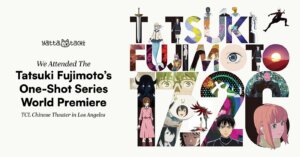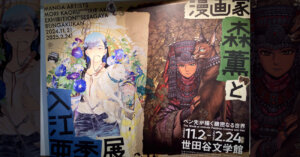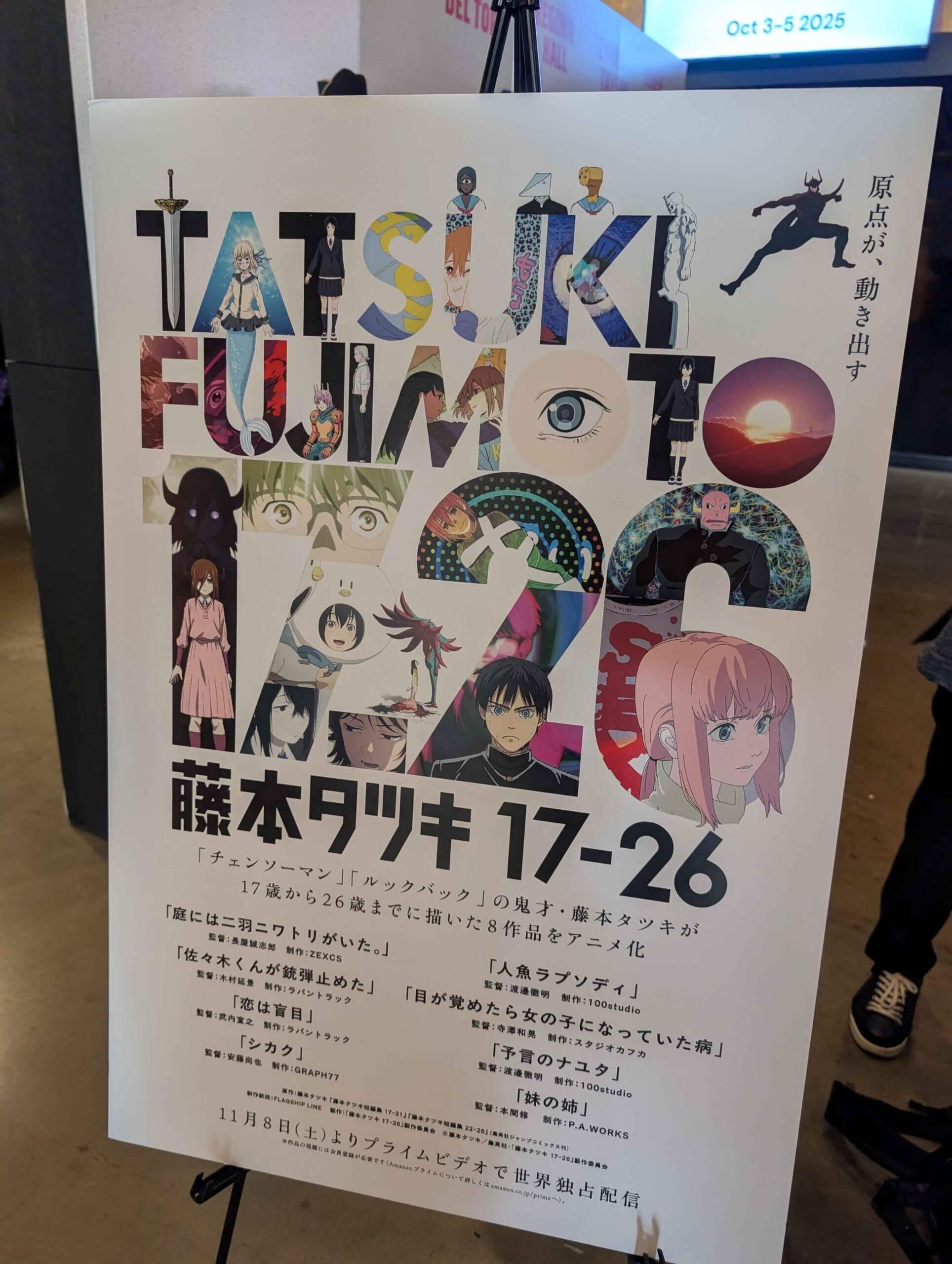
On October 5 2026, a packed theater of anime fans watched the World Premiere screening of Tatsuki Fujimoto 17-26 in the TCL Chinese Theater in Los Angeles. Adapted from the two-volume collection of manga one-shots, Tatsuki Fujimoto Before Chainsaw Man 17-21 and 22-26, this anthology series presented all eight comics as animated shorts. Though the animation for each short was in the hands of the different teams adapting them, audiences saw Fujimoto’s storytelling and thought processes develop in the order that he’d written them. What was he thinking about as a freshman mangaka? How did he present those ideas?
As a fan of Fujimoto’s work (Fire Punch, Chainsaw Man), I had read the one-shot volumes when they were first published in English. So I intentionally went into this screening without refreshing my memory. I also encouraged my travel partner to go in blind. I knew Fujimoto’s work often puts its audience in an uncomfortable place regarding sexual content, but experiencing that in real time with an audience was unnerving! Gasps, yelps, and groans at certain beats were thankfully balanced out by cheers, whoops, and clapping when the shorts resolved in a clunky but satisfying way. I had an idea of what I was going to see but actually experiencing it was something else, something crackly and exciting.
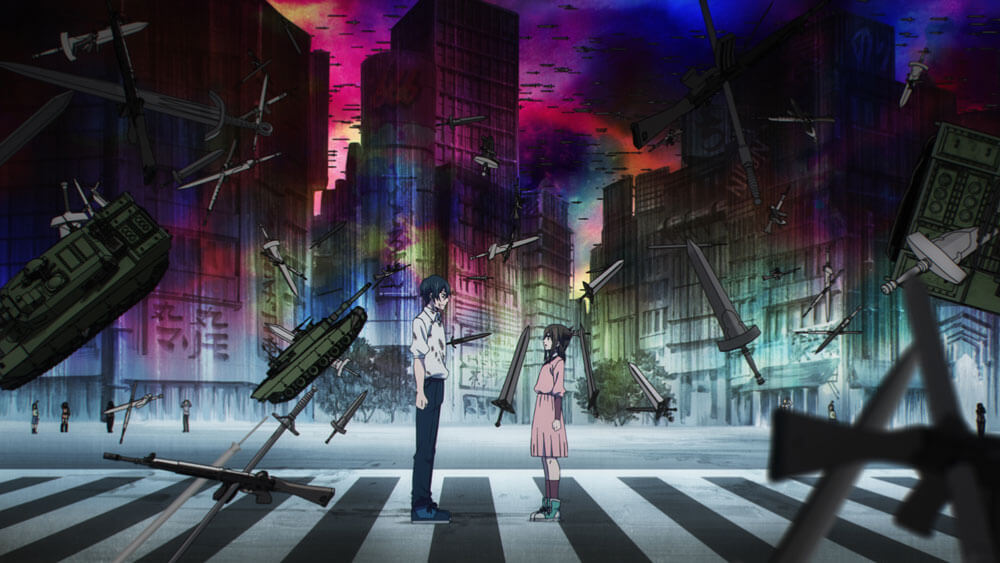
Our Favorite Shorts
My favorites of this bunch were Nayuta of the Prophecy and Love is Blind. The former starts with the birth of an incredibly powerful mage prophesied to bring about the end of the world. Her older brother Keiji protects her from those who want to kill her and prevent the apocalypse. But he struggles to understand how to take better care of her. The beat where he figures out that it’s not just about making sure she’s fed is heartwarming in the face of her potential for destruction.
In Love is Blind, the class president commits to confessing his love to his classmate by the end of the day, and he won’t let anything stop him. The short is less complex than the others, but the humor and sense of escalation had us laughing so hard it hurt. The protagonist’s confession kept getting interrupted by more and more ridiculous scenarios, and the resolution to each hitch makes me laugh just thinking about it. If there’s one short from this collection that I’d recommend to anyone, it would be that one. It had this incredibly charming appeal that I’m sure people will vibe with.
My travel partner was impressed by how many genres these shorts covered, from shonen action to slice of life and even tense family drama with a mature outlook. He felt that while A Couple Clucking Chickens Were Still Kickin’ in the School Yard (about humans disguising themselves as chickens to hide from aliens) and Shikaku (about an assassin meeting a vampire) weren’t as strong as the others, their character animation and action were a blast to watch. His top picks, though, were Love is Blind, Sisters, and Mermaid Rhapsody. The last of these made his top three because of his experience as a musician. He was drawn in by the atmosphere of the village by the sea and the lives dependent on it. The short’s dark and dangerous romance, with an emphasis on mermaids’ potential to be carnivorous predators, enchanted him just as much as the featured underwater piano.
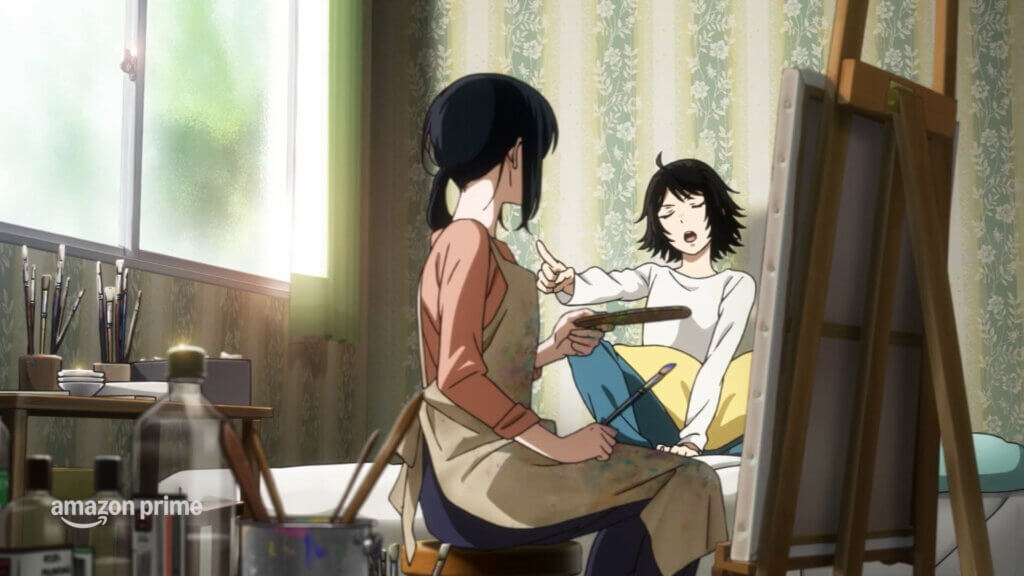
We were both glad that Sisters was the last short in the bunch, as its inclusion of non-sexual nudity, not present in the other shorts, was pretty shocking. By priming the audience with the first seven stories, we were made receptive to the idea that Fujimoto wasn’t being raunchy just for the sake of it and intended to express something meaningful. It’s our opinion that he stuck the landing, and the story’s resolution left us thinking about how siblings can create an ideal version of each other in their heads.
It’s About Communication
Though these stories’ narratives were largely disconnected, each story expressed a desire to connect and communicate with others. From trying to understand what people are like by living among them in A Couple Clucking Chickens, to struggling to express an ounce of affection in Love is Blind. Even seeing non-verbal cues for what they actually mean rather than what’s actually being said in Nayuta of the Prophecy. It’s heartening to see these works convey how tough it can be to express yourself and yet how rewarding it is when you figure it out.
In these one-shots we can also see prototypes of future character designs that Fujimoto would revisit in Chainsaw Man and Look Back. The protagonist of Shikaku looks eerily similar to Chainsaw Man’s Makima. Nayuta’s design returns in the Chainsaw Man manga’s second part. Though their relationship is different, the struggle of the Ehara sisters in Sisters runs parallel to the protagonists of Look Back and their one-sided adversarial relationship. Fujimoto tries out courageous but ultimately doomed heroes in A Couple Clucking Chickens, as well as first drafts of eternal beings steeped in ennui and listlessness like Shikaku’s vampires. His modern characters are all there in his past works, just less refined. Each new version is another attempt at communicating.

Production Team Q&A
After the shorts, the team at the screening moderated a question and answer session with series producer Ryo Oyama, as well as the directors Seichiro Nagaya (A Couple Clucking Chickens) and Nobuyuki Takeuchi (Love is Blind). Director Nagaya’s previous works include storyboarding and key animation for Chainsaw Man, Osomatsu-san, and Keep Your Hands off Eizouken. Director Takeuchi was a key animator for Spirited Away and Tenchi Muyou, as well as Chief Director for Sarazanmai.
When producer Oyama initially pitched the series to Fujimoto, the mangaka remarked that he would be embarrassed if they adapted his earlier works. But when Oyama introduced him to the lineup of directors on the project, Fujimoto felt confident that they could pull it off. Meanwhile, Director Nagoya expressed that he worked hard to convey the mundane daily lives of strange, fantastical man-eating aliens. He found it interesting that Fujimoto’s early works portraying brother-sister relationships also appear in Chainsaw Man.
As for Director Takeuchi, he was a very funny guy. In his introduction, he said he was thrilled to make it to Los Angeles, the home of his favorite TV series growing up: Columbo. Like the protagonist of Love is Blind, he remembered being embarrassed by feelings from his youth. It seemed like such a good fit for him that we were surprised to hear that it was actually the last project available by the time he joined.
Fujimoto often shows his characters watching movies, in his manga, whether in real or makeshift theaters (Fire Punch, Chainsaw Man, Goodbye Eri). Clearly movies are important to him; I hope he’s thrilled that Tatsuki Fujimoto 17-26 had such a glowing reception at the TCL Chinese Theater, in the heart of Hollywood.
Tatsuki Fujimoto 17-26 begins premiering on Amazon Prime starting in November 2025.
A special thank you to 33 USA Inc. for inviting us to attend the Tatsuki Fujimoto 17-26 event.
Article edited by: Adam Wescott

Featured Sponsor - JAST
The sweetest romance and the darkest corruption, the biggest titles and the indie darlings; for visual novels and eroge, there's nowhere better.
Big thank you to our supporters
From their continous support, we are able to pay our team for their time and hard work on the site.
We have a Thank-You page dedicated to those who help us continue the work that we’ve been doing.
See our thank you page
